Apr 15, 2013Fracking—short for hydraulic fracturing, which uses water pressure to create fractures in rock through which to extract natural gas and oil—has become a hot-button issue, as technology advances make recovering previously unreachable natural gas reserves economically feasible. Proponents argue for its role in boosting energy independence while opponents cite water contamination and other environmental concerns.
That's a debate for other venues. But what can't be disputed is the value RFID can bring to fracking operations. In 2011, for example, GreenHunter Water, a Grapevine, Texas, provider of water-management solutions and services to oil and gas companies, began installing its RFID-based wellhead-management system at six oil-drill sites in West Virginia. The solution lets the company track wastewater pumped out of temporary storage tanks and provide data showing it was deposited in authorized waste wells.
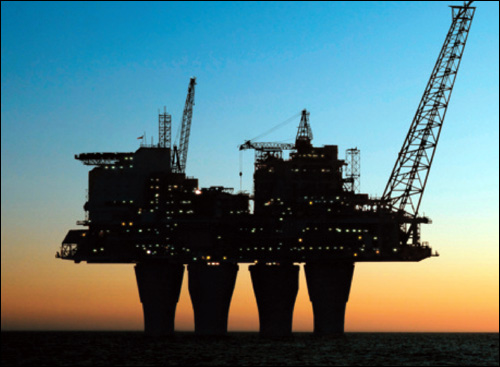
For the past year or so, Cameron, a provider of flow equipment products, systems and services to worldwide oil, gas and process industries, has been RFID-tagging valves and rental equipment for U.S. and Canadian hydraulic fracturing companies, to improve asset tracking and inventory management. Cameron links the unique serial number on each passive ultrahigh-frequency EPC Gen 2 tag to information about the part stored in its database. More than 10,000 pieces of equipment have been tagged, says Daniel Baxter, a senior technology and development research engineer at the firm.
Cameron moved fast to RFID-enable its 22 facilities that rent fracking equipment, because parts are not always returned to the location from which they were shipped. It was important to have all facilities go live as soon as possible, Baxter says, so everyone contributes to and can benefit from more accurate data. The RFID solution provides visibility into what equipment has been shipped to and returned from customers, and identifies items that are being repaired.
"Cameron sees great value and potential in RFID technology," Baxter says. The company can speed up billing and bring greater efficiency to other business processes, including turning around customer order cycle time, he says, adding that knowing the status of equipment is key to providing better service.
Improving asset tracking and inventory management is a major driver of RFID in the energy sector. A Louisiana service company became interested in RFID when it discovered that the pipes it had rented from another source to complete a customer's requirements were actually its own property. Only physical markings on the pipes gave away the truth, says Patrick King, founder of RFID rugged tag provider and consulting company Technologies ROI (TROI), and a standards and technology advisor to the Oil and Gas RFID Solutions Group (OGR), a consortium of experts working to promote RFID adoption in the energy sector. "When the boat out of Houma, Louisiana, goes out to an offshore wellhead and picks up parts for service, resurfacing or retooling, all the parts go on to that one boat barge," King says. "It comes in and someone does sorting, and the process is not very good. If 10 parts look the same, they end up in one pile, even if they're owned by three different companies. So you might or might not get your parts back."
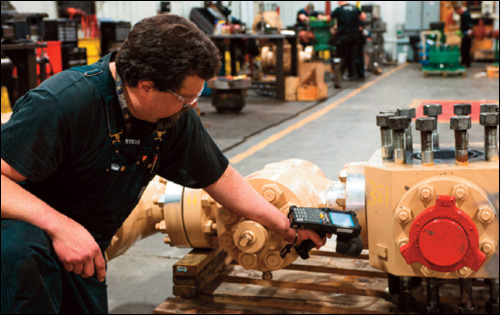
Managing assets in remote regions is particularly challenging. "It's very costly to send vessels to offshore oil rigs, so they need to make sure they're taking everything that needs to leave—that's a very laborious process to try to do manually," says Moses Chang, sales manager at RFID tag manufacturer Xerafy, which is working with one of the largest oil and gas logistics companies in the world on an effort to tag every production supply before it goes on board the vessels that service offshore operations in the Gulf of Mexico and other regions. Companies, for example, hoist slings and other pieces of equipment for lifting heavy gear into large containers, but counting them by hand is difficult, if not impossible, Chang says. "If you leave out one component, like one sling, or even one little tool, that can be a huge amount of downtime," he says. Downtime for offshore rig operations can run into the millions of dollars, and heading it off or recovering from it by sending out a helicopter with forgotten supplies can cost tens of thousands of dollars.
Oil and gas companies are also using RFID to improve drilling and maintenance operations, thanks to technology advances that make it possible to read tags on metal and in harsh environments (see BP Refines Maintenance Operations). In addition, they are implementing RFID-based real-time safety solutions to monitor employees in dangerous workplace environments. But most RFID deployments in the energy sector are closed-loop applications. The holy grail is to have RFID used across the supply chain—from the manufacturing site, where it can be attached to equipment being produced, to the wellhead, where it can be used in operations, King says.
Technology That's Up to the Job
To monitor valves and other equipment used in fracking, Cameron needed metal-friendly tags that could survive stress and harsh environments, so they would be readable when the assets were returned to its facilities. "There are all sorts of harsh chemicals that tags are exposed to, so the tags and attachment mechanisms have to hold up" on multiple fronts, Baxter says. "UHF tag technology has advanced so far recently and become so much more robust with companies like Xerafy, Omni-ID and Confidex. The tags have become so much more reliable in harsh environments, and offer improved performance when reading them on metal. It's become a good option for us. The technology has gotten to the point where Cameron is confident using these tags, which have a high survival rate."
The advancements in UHF technology also can facilitate oil and gas drilling operations and other processes that take place in the field, says Konrad Konarski, co-founder of the OGR. Workers can read RFID-tagged pipes to ensure the right pipes are going into a hole in the right sequence, for example, or that a pipe has been inspected following its use in multiple drilling cycles. Identifying drill pipes had its start with low-frequency RFID technology, he says. It provides adequate reliability but is hampered by a short read range that isn't best suited to work in complex drill rig environments.
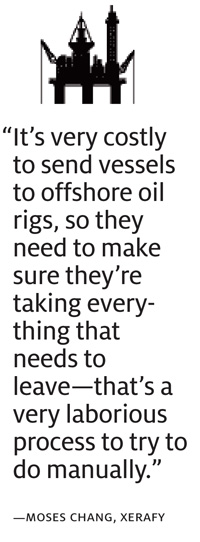
While the OGR promotes passive UHF EPC Gen 2 technology as a standard for asset management, low-frequency RFID continues to play a role. Last summer, for example, global oil and gas firm Statoil began deploying an LF RFID solution from Trac ID Systems at offshore oil wells to monitor the lifespan of drill pipes. Each time a pipe is lowered into and then raised out of the well, its tag ID number, along with the time and date, are automatically recorded. Tracking the pipes with fixed and handheld readers provides more accurate data than recording the information manually, and it also minimizes the time the rig crew must spend on the main deck, where they are exposed to various hazards.
Safety Takes a Front Seat
When it comes to the RFID projects being implemented around the world, personnel safety is right up there with asset-management solutions, says OGR co-founder Sam Falsafi. All five of the major oil companies—BP, ConocoPhillips, Chevron, Exxon and Shell—have major projects using RFID for personnel safety, he says. Some have been in place a few years, and at least one is tracking more than 4,000 people on a remote offshore platform.
Other energy firms are also deploying personnel safety solutions. Mexican oil-industry maintenance and transportation company Cotemar uses an RFID solution from AeroScout to automatically monitor employees, and the services they use, on four offshore platforms that serve as their living quarters while they work on oil rigs in the Gulf. This helps the company locate employees in the event of an emergency, and to provide food and laundry supplies more efficiently.
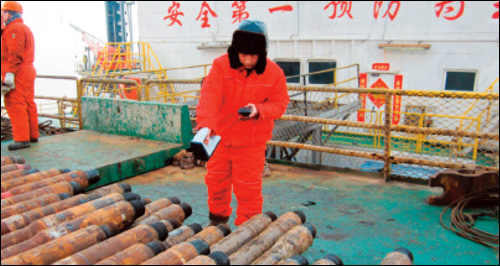
Agip Kazakhstan North Caspian Operating Co., a subsidiary of Italian oil and gas giant Eni, is deploying an RFID personnel safety solution in conjunction with the construction of a new complex and drilling site in the North Caspian Sea, off the coast of Kazakhstan. The oil field is expected to produce extremely toxic and flammable gas. Agip plans to monitor up to 1,000 staff members, so in an emergency it can determine which employees have reported to their assigned mustering stations as well as the locations of those who have not, and it can issue alerts in the right areas if a rescue is in order.
RFID-based personnel safety solutions provide real-time visibility into worker locations, to help prevent accidents and enable companies to respond should an incident occur. They can help keep accidents at bay by, for example, triggering alarms when nonauthorized contractors enter restricted work zones or notifying managers if noncertified operators near heavy machinery. "There have been incidents already where RFID technology has helped prevent accidents," Falsafi says, though the companies are careful about publicizing such events.
In an emergency, "the company can provide a better message publicly—explaining when the event took place, how many people were evacuated, that there are still people here in a certain sector, and so on," Falsafi says. "That's a much, much more powerful statement than just saying we know something took place, and we don't know where people are in the building or the facility, but we are trying to get them out."
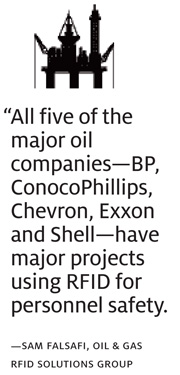
Most personnel safety solutions consist of a combination of real-time location systems based on ultra-wideband, ZigBee or Wi-Fi active RFID and GPS capabilities. "The unpredictable movement of persons and the complex petrochemical environments require, most of the time, a solution based on active RFID infrastructure," Falsafi says. Typically, he explains, workers are equipped with RFID-enabled ID badges; some also have panic buttons or embedded auxiliary sensors that could detect a fall to the ground or off a harness.
RFID technology allows us to effectively track people in an environment where GPS alone can't track people, Konarski says. While GPS on its own is sometimes suited to the task, "in a facility like a refinery, there is so much metal obstruction, and when you do have a GPS signal, it can be very diluted," he says. "GPS generally doesn't really let you track well in 3-D, so if a person is up on a stairwell, it's not easy to track him using a simple GPS receiver." That isn't helpful for localizing emergency response teams to where individuals are in trouble.
In addition to monitoring workers in dangerous environments, RFID can automate safety inspections. Omni-ID, for example, is working with a customer that sends ships back and forth to offshore rigs, says Andre Coté, the firm's SVP of business development. A strict inspection program on each ship requires not only ensuring the presence of fire extinguishers but also stress-testing on-ship components and parts of the ship itself, such as a doorway to ensure its hinges and locks work properly. With durable passive UHF tags attached to the appropriate locations and components on the ship, personnel need only ping the tag with a handheld reader to access complete instructions for what testing to do at each location. "And once they complete the tests, there's a full electronic record to show compliance with safety regulations for that ship," Coté says. The project is going live now across seven or eight ships, with some 10,000 tags per ship.
Connecting the Energy Dots
In the near future, more U.S. oil and gas companies may turn to RFID to comply with federal regulations. "The U.S. government is coming up with some very defined and stringent regulations for all the oil companies and producers in the U.S.," says Layne Tucker, founder of the EchoRFID solution for pipeline integrity management. "It's changing the way [the government is] going to regulate them, and how the oil companies have to keep track of their assets, and any changes they make in those assets over a 25- to 35-year life cycle, whether in an aboveground facility or a belowground pipeline."
The EchoRFID solution should be in use in the next few months, though the company is not disclosing customers now. Manufacturers or the oil companies constructing the pipelines can tag the equipment with Omni-ID's passive UHF Ultra on-metal tag. The tag was selected for its durability and read distance (more than 100 feet), Coté says. A cloud database will store information about each tagged piece every time its unique serial number is read—when the piece is transported to a construction site and when it's deployed as part of a pipeline project, including being buried deep within the ground. "When the pipe needs to be dug up in the future, the tag can be read and identified even before exposing the pipe," he says. As pieces of a pipeline deteriorate, new tagged parts can be put in their place; any database lookups would show the old tags are out of service and the new tags that have replaced them.
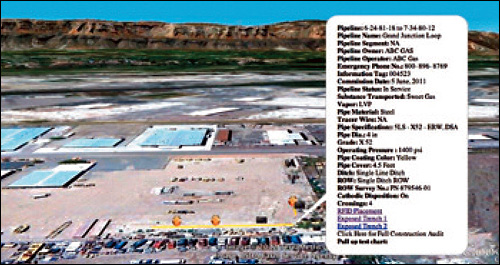
Pictures, voice and video also could be attached to the unique tag's information, and GPS technology would record where the asset has been placed. "You would be able to recall any changes for the full life cycle of that asset to those who need it out in the field," Tucker says. "You can't see the buried asset anymore, but we would be able to find any component a tag was on and reaffirm through GPS that that is the correct tag, you are at the spot you think you were, and this tag holds this information that was taken during construction, whether that was last week or five years ago," he says. "An engineer through his computer, without traveling to the field, can actually confirm the type of valve that's there, or people in the field can shoot the tag to see when and where the equipment was last serviced."
New federal guidelines could encourage more energy suppliers to RFID-tag equipment. For now, most RFID deployments in the energy industry tend to be of a closed-loop or otherwise isolated nature. That's something many parties would like to see change. There is still little agreement on data, material and referential standards to promote interoperability and usefulness, both within and across corporate borders, TROI's King says. "Unlike the auto industry, where at least there is an attempt by competitors to come together and drive common standards, the energy community does not really do that," he observes. "It is far more competitive."
"Tag specifications need to address the environmental and functional requirements of the entire life cycle of the product [the tag] is attached to," Konarski says. "But when efforts aren't thought of in an end-to-end way from the start, that's unlikely to happen.
"If you build a closed-loop system, you are isolating other partners from using RFID and it doesn't become as pervasive as it should," Konarski says. Consider, he suggests, the example of a large oil company whose warehouse group sponsors an RFID project to solve problems such as shrinkage or to receive inventory faster. The company selects RFID tags and technology to address its particular requirements. The tags may accompany parts out to the field, but the odds are they won't support requirements that would make them useful there.
"Even if someone else in the supply chain does decide to use RFID technology, if the original project did not take into account the types of information this trading partner would like to see in the tag memory, or the physical environment of the piece of equipment while in the hands of this partner, the tag may not work or simply will not provide [the secondary user] with any value," Konarski says. "Planning across different organizational units or different companies is key to leveraging the true value of RFID."
